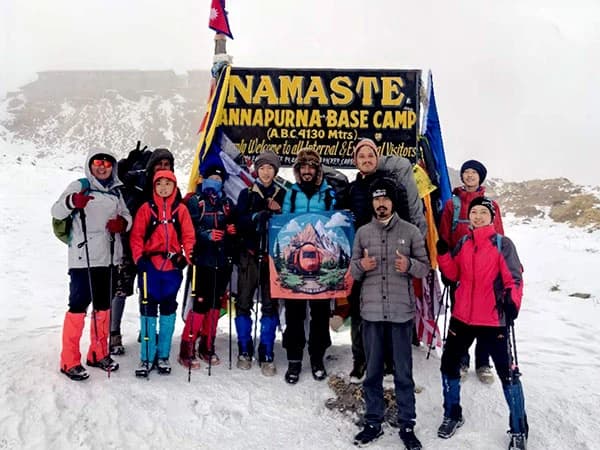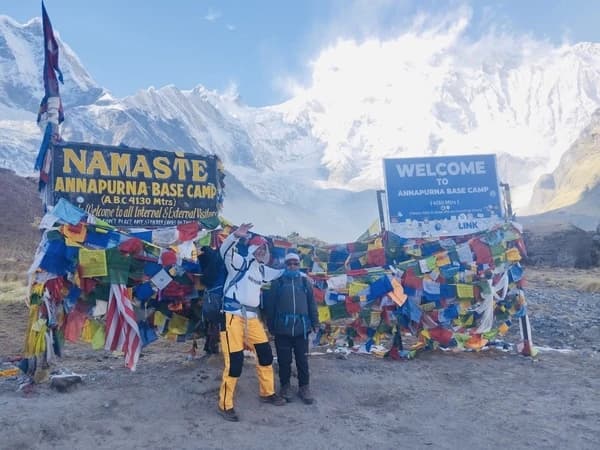The North Annapurna Base Camp trek is a less-traveled, challenging route in Nepal. It offers stunning, pristine views of the Annapurna massif, home to the world's 10th-highest mountain, Annapurna I (8,091m / 26,545 ft), as well as Dhaulagiri (8,167m), Hiunchuli (7,441m), Machhapuchhre (Fishtail) (6,993m), and other peaks exceeding 7,000 meters. Pancha Kunda Lake is a major highlight holy lake where adventure meets spirituality.
Everything You Should Know Before the Annapurna North Base Camp Trek: Complete Guide
About Annapurna North Base Camp Trek
The North Annapurna Base Camp Trek is a hidden gem in the Annapurna region of Nepal. It leads to the north face of Mount Annapurna I, the tenth-highest mountain in the world. Unlike the popular southern route, this trail is quiet and less crowded, offering a peaceful trekking experience in the heart of the Himalayas.
The trek starts from Narchyang village and takes you through beautiful forests, rivers, waterfalls, and traditional Magar and Gurung settlements. Along the way, you can enjoy breathtaking views of snow-covered peaks, especially Annapurna I and other surrounding mountains. The natural beauty and cultural richness make this trek both enjoyable and meaningful.
Also known as the Maurice Herzog Trail, the route follows the path taken by the first successful Annapurna expedition in 1950. The North Annapurna Base Camp Trek is ideal for adventure lovers looking for a unique and off-the-beaten-path experience in Nepal.
Annapurna North Base Camp Trek Overview
The North Annapurna Base Camp Trek is a quiet and beautiful trekking route in Nepal. It takes you to the north side of Mount Annapurna I, which is the tenth-highest mountain in the world. This trek is perfect if you want to explore the Himalayas in a peaceful and less crowded way. The journey begins from a village called Narchyang in the Myagdi district. As you walk, you will pass through green forests, rivers, waterfalls, and small villages.
This trek gives you amazing views of snow-covered mountains and lets you experience the culture of local people, especially the Magar community. You will also get to enjoy natural hot springs and quiet camping spots along the way. The trail follows the same route taken by Maurice Herzog, the first person to climb Annapurna in 1950.
The North Annapurna Base Camp Trek is more challenging than other popular treks, but if you enjoy adventure and nature, it is a great choice. It is best for trekkers who like to go off the beaten path. You will need good physical fitness and proper preparation, but the reward is a truly unforgettable journey in the Himalayas.

Highlights of Annapurna North Base Camp
- On your very first day, you’ll come across the Phutphute Waterfall, a stunning spot that’s perfect for a photo break.
- You’ll walk beside the beautiful Miristi River throughout the trek, adding peace and charm to your journey.
- As you climb higher, you’ll witness breathtaking views of Tilicho (7,135 m), Nilgiri North (7,061 m), and the Annapurna mountain range.
- The trek takes you through quiet forests and wild landscapes, rich with birds and natural beauty.
- You’ll pass through local villages, where you can see the daily life and culture of the Gurung and Magar people.
- Near the base camp, you’ll find the magical Panchakunda Lake (4,050 m), making this trek truly unique.
- Reaching North Annapurna Base Camp gives you a deep sense of adventure, peace, and achievement.
Which is the best time to trek to Annapurna North Base Camp?
When you plan to trek the North Annapurna Base Camp, choosing the right time is very important. The weather and trail conditions can change a lot with the seasons, so picking the best time helps you enjoy the trek safely and comfortably.
Spring (March to May)
Spring is one of the best seasons for trekking. When you trek during spring, you will see the forests come alive with colorful rhododendron flowers blooming all around. The weather is warm during the day but can be cool in the mornings and evenings. The skies are usually clear, so you get amazing views of the mountains like Annapurna, Tilicho, and Nilgiri. This time is perfect if you want a mix of good weather, beautiful nature, and fewer crowds compared to autumn.
Autumn (September to November)
Autumn is the most popular trekking season in Nepal, and it’s also a great time for the North Annapurna Base Camp trek. After the monsoon rains end, the weather becomes clear and dry. You will enjoy fresh air and bright blue skies, which give you the best mountain views. Temperatures are comfortable during the day but cool at night. Trekking in autumn is perfect if you want stable weather and great visibility.
Annapurna North Base Camp trek during monsoon
You should avoid trekking during the monsoon season (June to August) if you don't seek extreme adventure. Heavy rains make the trails slippery and dangerous, and the rivers can flood. Plus, the mountains are often covered in clouds, so you won’t get good views. Also, many teahouses may be closed.
Annapurna North Base Camp trek during winter
Winter (December to February) is very cold, especially at high altitudes. Snow can cover the trail, making it difficult to walk. If you choose winter, be ready for very cold temperatures and possible challenges on the path, and a jaw-dropping view.

Annapurna North Base Camp Trek Itinerary
Note: It is just a standard itinerary for the Annapurna North Base Camp Trek that is designed to minimize altitude sickness. However, it’s not necessary to follow the same plan. You can modify it according to your choice with the help of your local certified trekking agency, like View Nepal Treks & Expedition.
Permits for Annapurna North Base Camp Trek
To trek to the North Annapurna Base Camp, you need two important permits. The first is the Annapurna Conservation Area Permit (ACAP), which helps protect the natural and cultural environment of the region. This permit costs around NPR 3,000, which can be obtained in Kathmandu or Pokhara.
The second is the Trekkers’ Information Management System (TIMS) card, which keeps track of trekkers for safety reasons. The TIMS card costs about NPR 2,000 for an individual and is also available in Kathmandu or Pokhara. It’s important to note that if you are trekking alone, you must hire a licensed guide to get the TIMS card.
Both permits are mandatory for everyone trekking in the Annapurna region, and you can easily get them through trekking agencies or tourism offices before starting your trek.
How Difficult is the Annapurna North Base Camp Trek?
The North Annapurna Base Camp Trek is a new and less explored trail, making it more challenging than well-known routes like the classic Annapurna Base Camp trek. The trail is not marked properly, and there are very few signs or established paths, which increases the risk of getting lost, especially if you are planning for solo trekking. That’s why trekking with a licensed guide is strongly recommended for safety. The difficulty level, the trek is considered moderate, where you have to walk for long hours, steep ascents, and high altitudes. You’ll need to be physically fit and mentally prepared. Since the area is still in the development process, there are fewer teahouses and basic facilities, so proper planning is essential.

Altitude Sickness and Prevention in the Annapurna North Base Camp Trek
On the North Annapurna Base Camp trek, you will reach altitudes of over 4,100 meters, especially near Panchakunda Lake and the base camp. At this height, you may face Altitude Sickness (Acute Mountain Sickness or AMS) if your body doesn’t adjust properly to the lower oxygen levels and less hydration in the body.
Common Symptoms of AMS:
- Headache
- Dizziness
- Nausea or loss of appetite
- Shortness of breath
- Tiredness or difficulty sleeping
If ignored, AMS can become serious. So, it’s important to listen to your body and inform your guide.
Prevention
- Acclimatize properly: Walk slowly and take rest days to help your body adjust.
- Stay hydrated: Drink 3–4 liters of water daily; avoid alcohol and smoking.
- Eat well: Take enough calories to keep your energy up.
- Don’t rush: Gain altitude gradually; avoid rapid ascents.
- Take Diamox (if needed): Consult your doctor before the trek for preventive medicine.
- Trek with a guide: A guide can recognize symptoms early and help you decide whether to rest, descend, or continue.
Food and Accommodation in the Annapurna North Base Camp Trek: Services and Facilities
For the Annapurna North Base Camp Trek, you'll find a developing infrastructure focused on essential services. Recently, the local community established "tent hotels" along the trail, a significant upgrade from previous years, where trekkers had to be entirely self-sufficient with camping gear and food.
These tented hotels offer a bed and meals, eliminating the need to carry extensive camping equipment. While they provide crucial warmth and shelter, expect basic amenities. Modern luxuries like electricity, Wi-Fi, and hot showers are generally unavailable or limited. You'll likely encounter shared bathroom facilities.
Regarding food, you can anticipate nourishing, often organic, local meals. Dal Bhat (rice and lentil soup with vegetables), momos (dumplings), and noodle dishes are common. The menu may be less extensive than on commercial trails, but the food is typically fresh and prepared by the local community, offering a warm and authentic local experience. Remember to carry enough Nepali Rupees, as card payments are not an option.
Drinking water in the Annapurna North Base Camp Trek
Staying hydrated on the Annapurna North Base Camp Trek is essential, and you have a few good options.
You'll find natural water sources like streams and waterfalls along the trail. However, always purify this water before drinking! Water purification tablets or a reliable filter. This ensures safety from waterborne illnesses.
Additionally, most tea houses offer boiled water, which may cost you around $2 to $4. This is a safe and often preferred choice, especially at higher altitudes. Avoid buying bottled water to minimize plastic waste. Carry a reusable water bottle or two, and aim to drink 3-4 liters daily to avoid dehydration and altitude sickness.
Conclusion
The North Annapurna Base Camp trek is a serene and beautiful adventure for those seeking to explore a less crowded part of the Annapurna Region. This trail offers stunning views of the north face of Annapurna I and takes you throughMagar and Gurung villages, lush forests, and high mountain valleys feels like walking in four seasons.
It is more challenging than the popular south base camp trek, so it’s important to be well-prepared. You’ll need the right gear, a good level of fitness, and help from a local guide is highly recommended. The best time to go is during spring (March to May) or autumn (September to November), when the weather is clear and favourable.
If you’re looking for an adventurous and rewarding trek away from the crowds, the North Annapurna Base Camp Trek could be the perfect choice.
Bookings
If you're ready to explore the hidden beauty of the North Annapurna Base Camp, it’s best to book with a reliable trekking agency. View Nepal Treks & Expedition offers experienced guides, full support, and customized itineraries to make your trek safe and enjoyable.


.webp&w=3840&q=75&dpl=dpl_EiqBnGJVtEAU77Sszo4VoxKYvXf2)



.webp&w=1200&q=75&dpl=dpl_EiqBnGJVtEAU77Sszo4VoxKYvXf2)